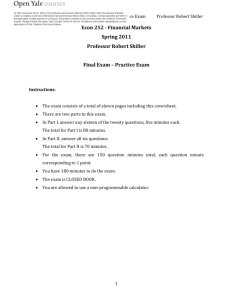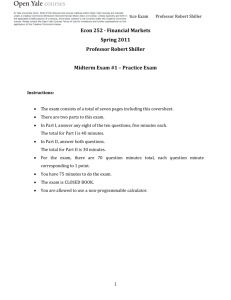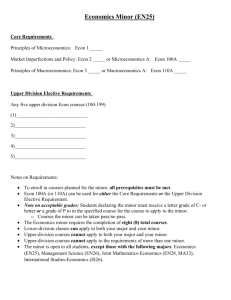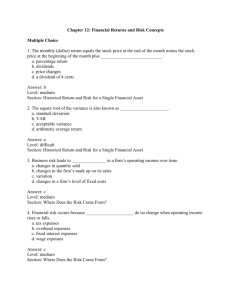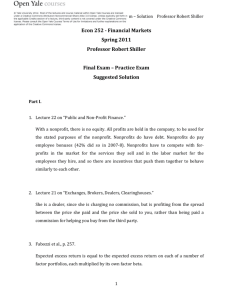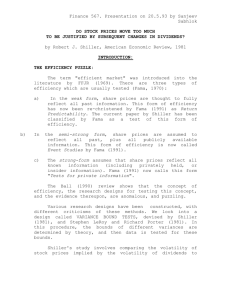Exam
advertisement
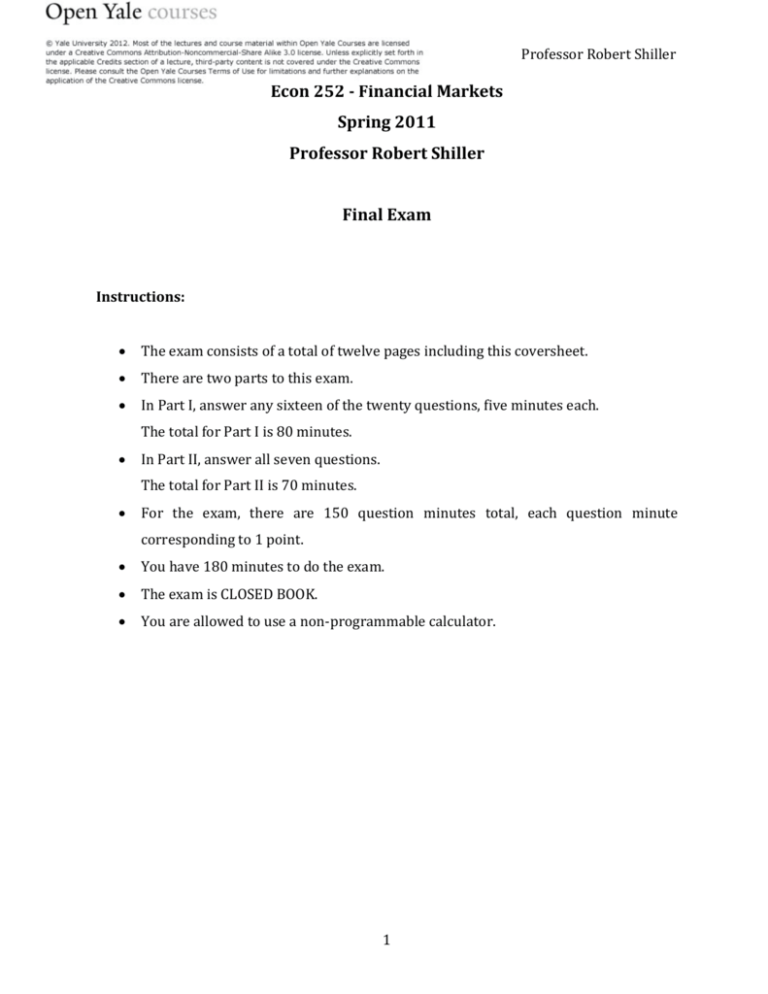
Econ 252 Spring 2011 Final Exam Econ 252 - Financial Markets Professor Robert Shiller Spring 2011 Professor Robert Shiller Final Exam Instructions: • • The exam consists of a total of twelve pages including this coversheet. • There are two parts to this exam. • The total for Part I is 80 minutes. • The total for Part II is 70 minutes. • corresponding to 1 point. • • In Part I, answer any sixteen of the twenty questions, five minutes each. In Part II, answer all seven questions. For the exam, there are 150 question minutes total, each question minute You have 180 minutes to do the exam. The exam is CLOSED BOOK. You are allowed to use a non-programmable calculator. 1 Econ 252 Spring 2011 Final Exam Professor Robert Shiller Part I. Answer sixteen of the twenty questions (5 points each - 80 points total). 1. If a customer places a buy order for one millisecond only on an electronic limit order book, what happens next in the case that the order is above the lowest offer? Alternatively, what happens if the order is below the highest bid? 2. How do futures exchanges prevent the problem of counterparty risk? 3. What was Laura Cha's point about jobs in the public versus the private sector? 4. What are two important milestones in the history of pensions, i.e. events, which made these plans better serve the interest of pensioners? 5. What are the principal agencies of the 2010 European Supervisory Framework, created in 2010 in response to the world financial crisis? 6. How does the physical delivery provision in futures markets enforce convergence of spot and futures prices on the expiration date of the contract? 7. What is the difference between term insurance and cash value life insurance? 2 Econ 252 Spring 2011 Final Exam Professor Robert Shiller PART I CONTINUES ON THE NEXT PAGE. CONTINUATION OF PART I. 8. A Canadian car dealer wishes to import cars from Germany. Describe how it might use bankers acceptances to finance the deal. 9. What is umbrella insurance? 10. What does Gary Gorton mean by “informationally insensitive debt”? 11. What is the difference between a capital budget and an operating budget for local governments, and which of the two is more relevant to constitutional balanced budget restrictions? 12. Why do some municipalities issue taxable municipal bonds, even though they are at a tax disadvantage and tend to pay a higher yield? 13. What is the Volcker Rule? 14. How does Rawls’ Theory of Justice apply to considerations of the fairness of financial markets? 3 Econ 252 Spring 2011 Final Exam Professor Robert Shiller PART I CONTINUES ON THE NEXT PAGE. CONTINUATION OF PART I. 15. What is the difference between pricing efficiency and operational efficiency? 16. Why do exchange-traded funds track underlying value better than closed-end funds? 17. What business is unique to a commercial bank, never done by an investment bank? Have “shadow banks” blurred this distinction? 18. What are dark pools? 19. Andrew Carnegie, in his The Gospel of Wealth, 1889, asked rhetorically “Why should a man leave all of his wealth to his children?” What was his answer and what were the reasons? 20. What has been the attitude of the G-20 countries to speculative bubbles since the 2007-2008 financial crisis? 4 Econ 252 Spring 2011 Final Exam Professor Robert Shiller Part II. Answer ALL SEVEN of the following questions. (Question 1: 6 points, Question 2: 10 points, Question 3: 5 points, Question 4: 14 points, Question 5: 12 points, Question 6: 8 points, Question 7: 15 points - 70 points total) Question 1 (6 points) Imagine that you are supposed to design standard coupon bonds that mature in 10 years. Coupons are paid semiannually with the first coupon payment occurring six months from now. (“Standard” refers to a non-callable bond contract that does not involve any default considerations.) (a) (3 points) In the following, you find the basic parameters of contract A that you have to adhere to: • • • Principal value: $50,000, Price of the contract today (i.e., 10 years before maturity): $47,000, Yield (annualized): 3.5%. What is the annualized coupon rate of contract A? (b) (3 points) In the following, you find the basic parameters of contract B that you have to adhere to: • • • Price of the contract today (i.e., 10 years before maturity): $175,000, Yield (annualized): 3%, Coupon rate (annualized): 2.5%. What is the principal value of contract B? 5 Econ 252 Spring 2011 Final Exam Professor Robert Shiller Question 2 (10 points) Consider a borrower that is approved for a standard 15-year, fully amortizing mortgage with an original balance of $335,000 and a note rate of 7.2%. (“Standard” refers to a fixed rate mortgage contract with level payments.) (a) (2 points) If the borrower purchases a house that is appraised for $400,000, what is the borrower’s LTV? In what regard is a borrower’s LTV helpful for a bank’s decision whether to accept or reject a loan application? (b) (2 points) What is the monthly mortgage payment for the borrower? (c) (6 points) Imposing the assumption that the borrower neither prepays nor defaults, write down part of the amortization schedule, limiting attention to months 70 and 71. Your amortization schedule should contain four columns: (1) Month, (2) Interest Payment, (3) Principal Repayment, (4) Remaining Mortgage Balance (in the beginning of the month). 6 Econ 252 Spring 2011 Final Exam Professor Robert Shiller Question 3 (5 points) Consider an imaginary Corporation X whose stock is publicly traded at the New York Stock Exchange. The value of its assets is $250,000,000 and the value of its liabilities is $200,000,000, according to its last quarterly filing with the SEC (Form 10-Q). (a) (1 point) What is the value of X’s shareholder equity according to its last quarterly filing? (b) (2 points) Suppose that there are 20,000,000 shares of Corporation X that trade at $6 per share. What is X’s market capitalization? Would you consider buying all shares of Corporation X to liquidate it? (c) (2 points) Imagine that X issues bond contracts, which are worth $1,000,000, as well as new shares, which are worth $4,000,000. Corporation X keeps all the proceeds without re-investing them. What is the new value of X’s assets, liabilities, and shareholder equity? 7 Econ 252 Spring 2011 Final Exam Professor Robert Shiller Question 4 (14 points) Throughout this question, assume that an investor is contractually barred from purchasing asset Y in the current period (period 0). However, the investor is free to short-sell asset Y in period 0. Suppose the price of asset Y in period 0 is $200 and this asset will pay a dividend of $6 one year from now in period 1. Let the interest rate from period 0 to period 1 be 4%. (a) (7 points) Assume the price for a futures contract with delivery in period 1 is $210. Can the investor make an arbitrage profit when this is the price? If so, state specifically what financial transactions she would make in period 0 and period 1 to realize a profit. If not, explain why not. (b) (7 points) Now, assume the price for a futures contract with delivery in period 1 is $190. Can the investor make an arbitrage profit when this is the price? If so, state specifically what financial transactions she would make in period 0 and period 1 to realize a profit. If not, explain why not. 8 Econ 252 Spring 2011 Final Exam Professor Robert Shiller Question 5 (12 points) Consider the following two assets: • • Asset A’s expected return is 3.5% and return standard deviation is 45%. Asset B’s expected return is 1.0% and return standard deviation is 35%. The correlation between assets A and B is 0.4. The table below indicates the expected return and the return standard deviation for portfolios that put weight w on asset A and weight 1-w on asset B. Weight Expected Return Return Standard Deviation w=1.3 4.25% 55.15% w=0.2 1.50% 32.66% w=0.7 2.75% 36.97% (a) (3 points) Draw a careful sketch of the portfolio frontier associated with assets A and B. Clearly indicate assets A and B as well as the three portfolios from the above table. Also, clearly label the part of the portfolio frontier in which you short-sell asset A as “SHORT A” and the part (of the portfolio frontier) in which you short-sell asset B as “SHORT B”. 9 Econ 252 Spring 2011 Final Exam Professor Robert Shiller QUESTION 5 CONTINUES ON THE NEXT PAGE CONTINUATION OF QUESTION 1 (b) (4 points) Now, suppose that the correlation between assets A and B is changed to -0.4. What is the expected return and the return standard deviation for the portfolio associated with the following three portfolio weights: • • • w=1.3, w=0.7, w=0. If you can make a clear argument for the value of the expected return or the return standard deviation, provide this argument. Otherwise, show the computation(s). (c) (2 points) According to your answer to part (b), how do you evaluate the following statement: Independent of the portfolio weight, lowering the correlation between assets A and B implies that an investor whose utility strictly increases in expected return and strictly decreases in return standard deviation is always at least as well off as before. In short, lowering the correlation between assets A and B always entails diversification benefits. (d) (3 points) Go back to your drawing from part (a). Assume that the upper part of the portfolio frontier that you have drawn in that part represents the Efficient Portfolio Frontier of some set of assets that we will not specify any further. Suppose that the risk-free rate is 0.5% and draw a careful sketch of the tangency line. Clearly indicate the Tangency Portfolio. Moreover, label the region along the tangency line that entails short-selling of the risk-free asset by “SHORT RF”. 10 Econ 252 Spring 2011 Final Exam Professor Robert Shiller Question 6 (8 points) Assume that all put options mentioned below are European style, have the same maturity date and are written on stock ABC. Moreover, ignore any discounting between the date at which an option is purchased and the date at which it matures. Stock ABC costs $60 today. Consider three different put options: • • • Put option P1 has a strike price of $100 and costs $55. Put option P2 has a strike price of $70 and costs $29. Put option P3 has a strike price of $50 and costs $16. Suppose an investor purchases a “long put ladder”. That is, she buys one unit of P1, sells one unit of P2, and also sells one unit of P3. Draw the payoff and profit of this portfolio at maturity. Judging from your graph, why do you think an investor might want to construct this portfolio? 11 Econ 252 Spring 2011 Final Exam Professor Robert Shiller Question 7 (15 points) The price of XYZ stock is currently $100. The stock price will either increase by a factor of u=1.5 or decrease by a factor of d=0.5 in each of the following years. (Stock increases and decreases in different years are independent from each other.) The annual risk-free rate for the next two years is constant at 2%. XYZ stock does not pay any dividends. First, consider a European call option C1 written on XYZ stock with a strike price of $60, which matures in 1 year. (a) (2 points) Suppose that an investor wants to create a portfolio today that generates the same payoffs in both states of the world in 1 year, using XYZ stocks and the call option C1. Calculate the number of XYZ stocks, which an investor should purchase per call option C1 that he sells. (b) (3 points) What is the price of the call option C1 today? Now, consider another European call option C2 written on XYZ stock with a strike price of $60, which matures in 2 years. (c) (6 points) What is the price of C2 a year from now after the price has gone down once? What is the price of C2 today? (d) (4 points) Using your answer in part (c) and the put-call parity, calculate the price of a 2-year put with the same strike price as C2 a year from now after the price has gone down once. Additionally, what is the price of this put option today? 12
